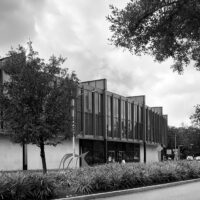Non-city
Published as Timmermansoog column on: website Architectenweb, January 2019
The countryside is everything that is non-city, Rem Koolhaas recently claimed. In a conversation with Louise Fresco at De Balie, he demonstrated that the countryside is subject to new dynamics. New methods of production are emerging. The non-city is being colonized in new ways by the true-city. Not long after that, I took a road trip through Texas.
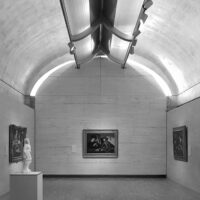
The destination of the trip was the Louis Kahn-designed Kimbell Art Museum in Fort Worth, a city the size of Amsterdam close to much larger Dallas. We left from Houston. From the straight stretch of Interstate 45, the Texas non-city passed me by for 260 miles. That landscape resembled an immense infrastructural strip settlement. The highway has parallel lanes in most places. Around the cities, those serve industrial businesses, beyond that usually food and agricultural wholesalers, motels and petrol stations.
We refuelled in Buffalo, not to be confused with the city of Buffalo in New York, one of those unfinished colonies with lots of emptiness where the main street is as wide as the Interstate. Never before have I seen so many birds of prey. This is not a natural occurrence. The birds live on hit game on the Interstate. An even more gruesome detail: the strip settlement houses almost all Texas prisons. The Huntsville Unit, which specialises in carrying out the death penalty, is pretty much in the middle.
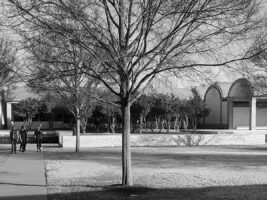
The Kimbell Art Museum is located in Fort Worth’s university district. The building did not disappoint. You can see the art in rooms finished with wood, concrete and travertine. The building was built with great care. The museum architecture frames the experience of the art. There are no sterile white rooms where everything and nothing is possible. At the back of the building is a garden that literally rises above Fort Worth. OK: I felt at ease. However, the idyllic garden and the convenient museum rooms exist by the grace of solid garden walls and an entrance facade that is virtually closed. The Kimbell keeps its eyes down on public space.
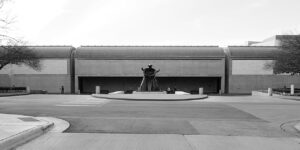
We explored Main Street, the dead-straight axis connecting Fort Worth’s upper city to the lower city, which largely passes by dilapidated industrial sites. The non-city appeared to be reclaiming the true-city. On an asphalt field was an open-air cinema without many visitors. We could tell from the old buildings that this must have been the town’s origin; where meat was processed and traded. After a few miles, we arrived at the Stockyards, known for rodeo shows. Walking in the streets were men with boots, jeans and big white Statsons. They ate meat and chips and drank beer. Punks from the suburbs, my American travelling companions thought.
There is no shortage of space in Texas. Land is cheap, which encourages real estate consumption. Reusing or intensifying land and buildings is much more cumbersome than leaving things as they are and starting over elsewhere. Texas has no income and corporate taxes. The state relies largely on relatively high property taxes. Valuations are negotiable, as in the Netherlands. Real estate owners present the return on their property as unfavourably as possible. There are no incentives to maintain vacant property. The result is large-scale reclamation of the non-city at the expense of extensification of the Houston and Dallas true-cities. The metropolises have claimed the outlying areas and are now vacating themselves.
Unfortunately, Koolhaas hastily ignored the definition of the true-city at De Balie. The latter, unlike the non-city, would be characterised by diversity. In the case of the prison village near the Huntsville Unit, Koolhaas could be right. On the other hand, one could also maintain that the informality of such a settlement is actually very urban, because living, working and farming are mixed there. And just how diverse is Fort Worth with all that wasteland and improvised parking or storage lots? How urban is the rodeo paradise for sub-urbanites? The extreme conditions in Texas suggest that the non-city and the true-city, while complementary, are the product of the same socio-economic politics. In any case, the contrast between the two is not overly obvious.
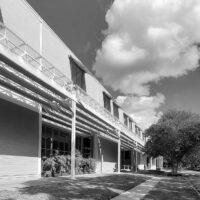
The opposite of the city is and remains architecture: buildings make up the non-city. The Kimbell Art Museum is just one example. Other Texas museums, designed by Renzo Piano, Ludwig Mies van der Rohe and Rafael Moneo, also do not face the pressure of diverse city life. By necessity, architects of this calibre designed buildings with benevolent interiors without speaking faces, facades without façades. Such buildings do not make a city.
From this laboratory one can learn that the city’s diversity is all about economic pressure and scarcity. Without those pressures, the city weakens and any form of urbanity or diversity becomes dependent on the agonisingly low turnover rate of its real estate. For a long time, colonisation of Dutch Vinex areas has stood in the way of inner-city renewal. In the absence of expansion areas, the Dutch city is now hot. What would happen if economic pressure and scarcity of building land subsided again?
